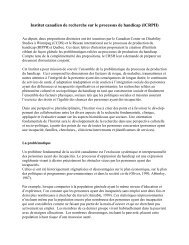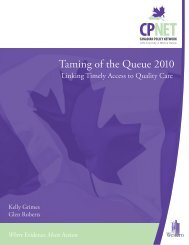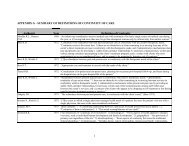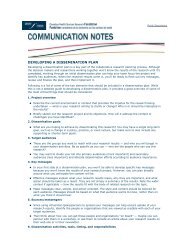Full Report - Fondation canadienne pour l'amélioration des services ...
Full Report - Fondation canadienne pour l'amélioration des services ...
Full Report - Fondation canadienne pour l'amélioration des services ...
You also want an ePaper? Increase the reach of your titles
YUMPU automatically turns print PDFs into web optimized ePapers that Google loves.
Context<br />
The viability and integrity of the health care system is possibly the most important preoccupation<br />
of the Canadian population as emphasized in the recent report of the Commission on the Future<br />
of Health Care in Canada 1 . The public perception of our health care delivery is that it is itself<br />
ailing as a result of deep budget cuts and inefficiency. Policy makers are eagerly seeking<br />
creative and innovative solutions that can reduce the frustration that both patients and health care<br />
providers experience when navigating the system. A possible solution to improve the<br />
satisfaction and quality of care is to address the continuity of care problem. Actual dysfunction<br />
of the health care system is often associated with emergency department (ED) overcrowding.<br />
Recent headlines appearing nation-wide have highlighted this crisis in ED care. Issues faced by<br />
EDs across the country and solutions to solve them are of keen interest to policy makers. A<br />
suggested means of improving continuity of care would be through enhanced linkages between<br />
the ED and the primary care network (PCN) which would result in a more appropriate, efficient<br />
and rational utilization of resources in both milieus. Thus, the aim of this project was to explore<br />
the deficiencies in communication between EDs and PCPs, develop a computer-based electronic<br />
network that would serve as a standardized communication system (SCS) linking the ED and<br />
PCPs and measure the impact of such a system.<br />
Unfortunately, very little communication exists between these two sources of care. Physicians<br />
from both the ED and the PCN must treat and manage patients with missing or incomplete<br />
information. Continuity of care between the ED and the PCN depends on improving<br />
communication between these two settings 2 . Knowledge of a patient’s visit to an ED is critical<br />
for PCPs since it allows them to know that their patient has experienced a major change in their<br />
health status. Perhaps more importantly however, it will enable informed and effective followup<br />
of an ED visit and empower the PCP to act as a real coordinator of care 3 . In order to achieve<br />
these fundamental objectives, the PCN must, at a minimum, have knowledge of the visit, the<br />
diagnosis, and the treatment plan. Such information is all too often unavailable to family<br />
physicians in a format that is both sufficiently detailed and accessible in a reasonable time frame<br />
to allow participation in a patient’s medical care. Family physicians have indicated that<br />
continuity of care is difficult in the PCN because of significant problems with communication<br />
between acute care facilities and the PCN 4 . Family physicians report problems with obtaining<br />
1














